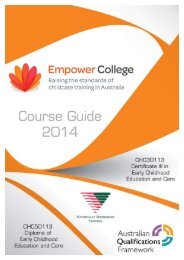Anaphylaxis Management Guidelines
Create successful ePaper yourself
Turn your PDF publications into a flip-book with our unique Google optimized e-Paper software.
New and relief/casual staff will be given information about children’s special needs (including<br />
children with severe allergies) during the orientation process.<br />
The child care service will discuss the provision of a Medic Alert bracelet for the child at risk of<br />
anaphylaxis with parents/guardians.<br />
Staff training<br />
An appropriate number of staff will be trained in the prevention, recognition and treatment of<br />
anaphylaxis in child care settings, including the use of adrenaline autoinjectors.<br />
Each child care service will need to determine which of their staff should be trained to ensure<br />
that someone in close proximity to the child is always on hand to act in an emergency. In a small<br />
service this may mean that all staff should be trained, whilst in a larger service it may be sufficient<br />
for only those staff who work with the child to be trained. Best practice, however, would be for all<br />
staff to undergo training so there is always support in any situation.<br />
The child care service will ensure the Food Coordinator is trained in managing the provision of<br />
meals for a child with allergies, including high levels of care in preventing cross contamination<br />
during storage, handling, preparation and serving of food. Training will also be given in planning<br />
appropriate menus including identifying written and hidden sources of food allergens on<br />
food labels.<br />
The child care service will have available adrenaline autoinjector trainers to allow staff to practise<br />
using the devices.<br />
<strong>Anaphylaxis</strong> emergency procedures will be conducted and evaluated every six months to ensure<br />
staff are confident in the procedure and able to act in an emergency.<br />
Emergency procedures<br />
The child’s Individual <strong>Anaphylaxis</strong> Health Care Plan should be completed in consultation with the<br />
child’s parents/guardians. Such consultation includes:<br />
approval of the Plan;<br />
consent to display the child’s ASCIA Action Plan;<br />
consent for the information contained within the Plan to be made available to both child care<br />
staff and emergency medical personnel (if necessary).<br />
The child’s Individual <strong>Anaphylaxis</strong> Health Care Plan must include information relating to the<br />
immediate transport to hospital in an ambulance after an anaphylactic reaction. Repeat episodes<br />
of anaphylaxis may necessitate the child requiring additional medical treatment.<br />
The child’s ASCIA Action Plan will be placed in a prominent position. This will ensure it can be<br />
regularly read by child care staff where the child may be present during the day. The need to<br />
display the child’s ASCIA Action Plan will be fully discussed with the child’s parents/guardians and<br />
their authorisation obtained for this.<br />
The Supervising Officer will inform the child care service management of the agreed Individual<br />
<strong>Anaphylaxis</strong> Health Care Plan for the child and obtain their endorsement for the Plan to proceed.<br />
All information on the child’s Individual <strong>Anaphylaxis</strong> Health Care Plan should be reviewed<br />
annually with the child’s parents/guardians to ensure information is current to the child’s<br />
developmental level.<br />
The child’s Individual <strong>Anaphylaxis</strong> Health Care Plan should be reviewed prior to any special<br />
activities (e.g. excursions) to ensure information is current and correct, and any specific<br />
contingencies are pre-planned.<br />
28 <strong>Anaphylaxis</strong> <strong>Management</strong> <strong>Guidelines</strong>





